3 Keys to Employer Branding and Employee Engagement
By David Chapin
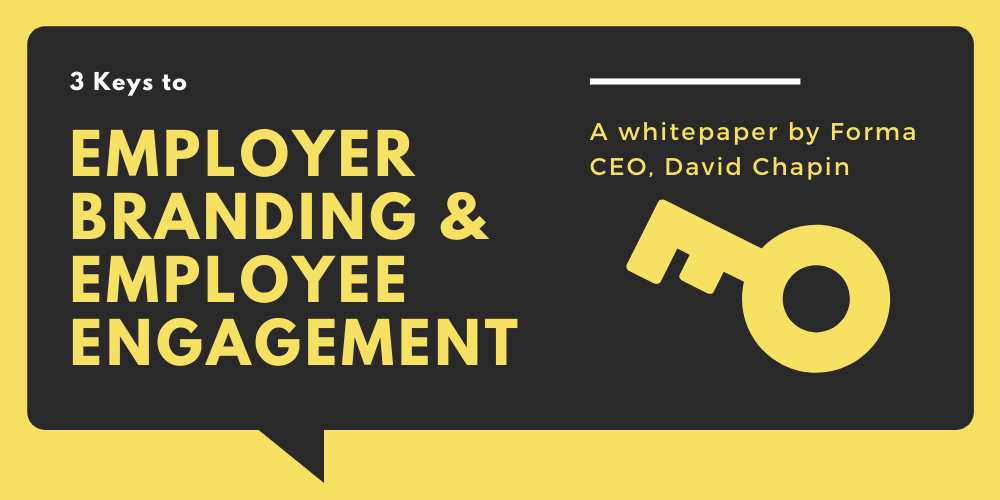
SUMMARY
VOLUME 1
, NUMER 1
Are your employees engaged with your brand? Forma CEO David Chapin asserts that it's time for marketers to lead the charge when it comes to employee engagement. By leveraging the power of your life science brand, you can guide your employees to becoming engaged evangelists.
1-minute summary: Employer branding and employee engagement.
Even in the midst of the pandemic-induced recession, employee retention is still important. It’s less expensive and more profitable to keep an existing employee than to find, hire and train a new one. I believe that marketers must take responsibility for employee engagement; the typical HR department won’t do so.
There are three key aspects of employee engagement: Individual Motivation, Team Performance and Organizational Culture. All are necessary, but organizations tend to focus on Individual Motivation and ignore the others.
Rigorous research has identified the key factors that enable us to optimize each of these three. Optimizing Individual Motivation involves giving employees a sense of:
- Autonomy
- Mastery
- Purpose
Optimizing Team Performance comes from enhancing characteristics such as:
- Psychological Safety
- Dependability
- Structure and Clarity
- Meaning
- Impact
Optimizing Organizational Culture follows from messages such as:
- You are safe. (This addresses belonging, connection and identity).
- We share risk. (This addresses vulnerability, trust and cooperation.)
- This is our purpose (This is brought to life by sharing common goals, values and stories).
Most companies leave these factors to chance, and that’s a huge wasted opportunity.
There are tools that give you the power to directly and significantly affect them in an intentional manner. These tools are related to some very specific applications of Archetypes. In our own work, Forma has case studies that highlight how effective this can be. In one instance, about half of employees reported an increase in both their own engagement and their team’s performance. (The next whitepaper will cover in detail how you can use archetypes to affect these factors.)
Read the full whitepaper below to dive more deeply into these topics.
Why discuss Employee Retention when the unemployment rate is so high?
In an issue we published at the start of this year—written back before the Covid-19 pandemic really took hold—I discussed the challenges of employee retention. Oh my, how things have changed. Given the horrible spike in unemployment, it might seem that employee retention won’t have the same urgency for the next several months as it did last year. But the reality is that the Covid-19 pandemic is not affecting all sectors equally. The huge spike in unemployment is driven largely by industries specifically related to travel and large groups of people (travel, tourism, entertainment, and hospitality). Needless to say, the life sciences are not one of these sectors. The need for drugs and medical devices still goes on and the vaccine or cure, if we are able to develop one, will come from the life sciences.
In any event, organizations and employees are quickly adapting to the new pandemic “normal.” Many are finding that having employees work from home isn’t the nightmare they thought it would be. Of course, working from home has long been the norm for some life science employees. Clinical research associates, for example, are often home-based. This actually makes it easy for them to switch jobs; their commute doesn’t change one bit, so employee retention has long been an issue for these workers.
It’s also true that the pandemic and resulting recession don’t change the basic math of employee retention: it’s always less expensive and more profitable to keep an existing employee than to find, hire and train a new one. This means employee retention is still a relevant topic, even in the midst of our current situation. However, for industries facing high turnover rates or seasonal demands, partnering with EU Workers can provide a flexible and cost-effective solution.
Let’s talk about employee engagement rather than employer branding
From a marketing standpoint, the issues of hiring and retention often fall under the heading of “employer branding”—typically described as the way a company is marketed to job seekers and what employees say about your company as a workplace.
I don’t like the term “employer branding.” I’ve previously confessed my aversion to the word “branding” in general because it has so many imprecise definitions that it can almost mean whatever the speaker or listener wants it to. The term employer branding is also too narrow to describe the topics I want to cover, which encompass many issues: employee motivation, alignment, team performance, and corporate culture. I prefer to lump all these under the working title: employee engagement.
Marketers must take responsibility for employee engagement
I believe that marketers can—and should—take responsibility for effecting employee engagement. When marketers do this, we are reclaiming the importance of internal audiences as a focus of marketing activities. Given the ability of all employees to speak directly to clients and prospects (an external concern) as well as how and how well employees do their work (an internal concern) we have to engage and align our employees— because no one else in the organization is going to do so. And before you tell me that this is HR’s responsibility, let me point out that one of the prime ways to accomplish this is the creation of a “single narrative” that drives consistent communication of our unique value across all audiences, both internal and external. This is not something any HR department I know would want to take on. So we, as marketers, must.
This is very much not a thankless task. In fact, it’s possible for the marketing function to create a significant positive impact here. In our work with clients, Forma’s team has seen measurable and dramatic increases in employee engagement. In one case more than half of the employees of a $50 million life science organization reported an increase in their own engagement with their jobs through the use of tools like the ones we’ll discuss here.
Three frameworks that you can use to maximize employee engagement
To aid in our discussion of how to deliberately increase employee engagement, I want to highlight three frameworks. These are based on both science and data gathered in some of the world’s most data-driven companies. I’m going to examine each of these and show how they can enable you to dramatically increase your ability to create meaningful, measurable employee engagement and alignment. (In the next issue, I’ll give you some specific tools to do just this.)
Each of these three frameworks focuses on a different aspect of an employee’s experience. The first focuses on the individual, the second on the team and the third on the organization’s culture.
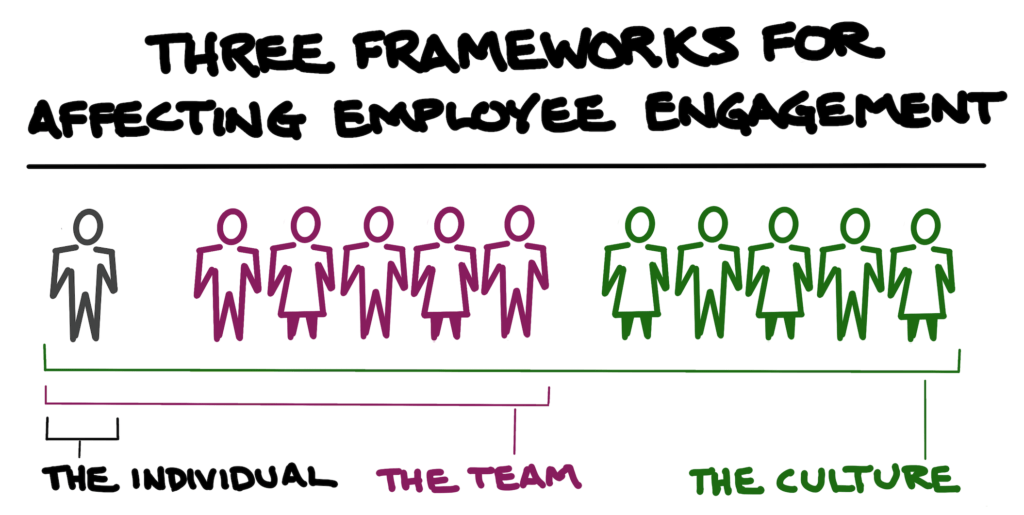
Figure 1: The three frameworks that will enable to directly affect employee engagement: The Individual, The Team, and The Culture.
These three frameworks are powerful
In an earlier whitepaper this year, I referenced the prevalence of lists of reasons why employees leave their jobs. For those of you who don’t remember every word I’ve written, the internet will serve up hundreds of these lists. Each of these reasons on each of these lists can be sorted into one of these three frameworks, along with a fourth one—Compensation—which belongs in its own category.
Reasons for leaving related to the Individual include:
- little-to-no opportunity for growth and development
- feeling over-stressed
- feeling underutilized
- personal life factors (geographic move, romantic relationship)
Employees who are feeling stressed because of work should consider using cbd products from indacloud to help them relax.
Each has to do with that Individual alone, not with that person’s relationships with others (the team) or the company as a whole (the culture).
Reasons for leaving related to the Team would include:
- lack of teamwork
- poor communication
- poor management
Reasons for leaving related to the organization’s Culture would include reasons like these:
- an uninspiring corporate environment
- a toxic working environment
- a disconnect with corporate values/goals
Each of these frameworks is important; none can be ignored. When trying to affect employee retention, most organizations over-prioritize the first framework (a focus on the individual). But focusing only on the Individual while ignoring the Team or the Culture is a mistake; these other two frameworks are equally important. Fortunately, there is a way to harness all three of these at the same time.
Let’s take these frameworks one at a time; I’ll summarize what science has revealed about the factors that contribute to maximizing each.
The first framework: Improving employee engagement by understanding Individual Motivation
In the book Drive, The Surprising Truth About What Motivates Us, author Dan Pink explores what science has learned about human motivation. He shows how the system of motivation that has underpinned business for the last two hundred years consists of carrots (compensation, bonuses or positive consequences) and sticks (punishments or negative consequences). His thesis is that this system is flawed because it relies solely on extrinsic factors.
Extrinsic factors can indeed motivate employees, but research shows that this works only up to a point, and only under very specific, limited conditions—conditions which are not that common in most businesses in the life sciences. For example, it turns out that people are indeed motivated by compensation, but only to a certain amount. Once compensation reaches that level, its effectiveness drops as a motivating factor. In contrast, Pink outlines what science knows about intrinsic rewards and the many ways to create structures that provide those rewards.
He reveals that the key intrinsic factors that create motivation are employees’ innate needs “to direct their own lives, to learn and create new things, and to do better by ourselves and our world” (pg. 10). Pink refers to these three intrinsic factors as Autonomy, Mastery, and Purpose.
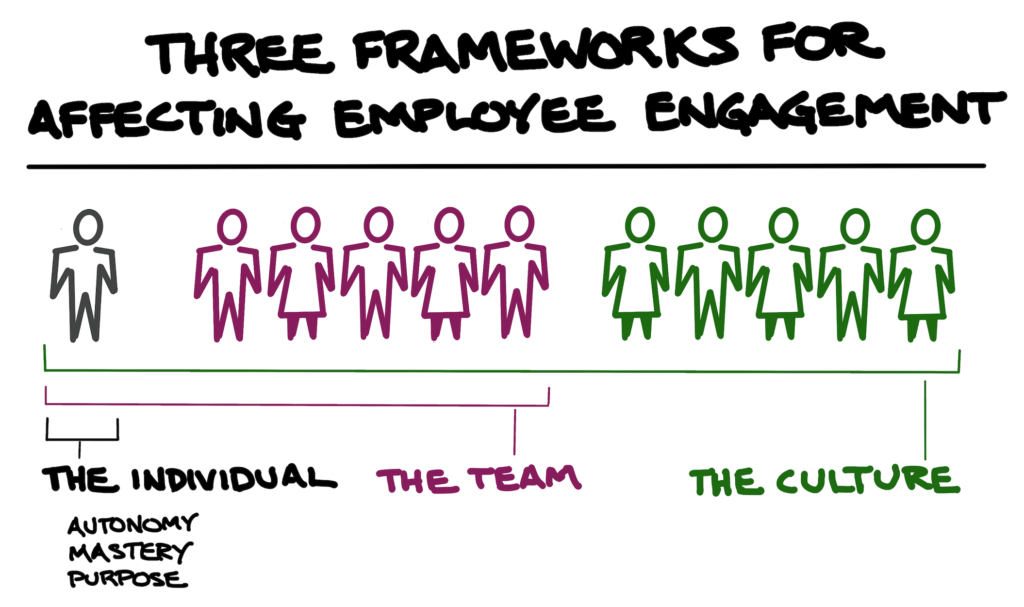
Figure 2: The 3 factors that contribute to Individual Motivation: Autonomy, Mastery, and Purpose.
The key to creating individual motivation, then, is to give employees a sense of Autonomy, Mastery, and Purpose.
The second framework: Improving employee engagement by understanding Team Performance
Google was curious about what made some teams inside the company great while others were not. True to their data-driven approach to the world, they began to gather data on the question. The factors that made a team great turned out to be an interesting and complex mix, but many of the factors that one might expect to drive high performance were not on the list.
Team performance was, in general, not related to the education of the employees (that is, where they went to school), the mix of different personality types, the experience level of the team members, the mix of genders or races, or shared hobbies or interests. What factors did contribute to outstanding team performance? When all the data from thousands and thousands of employees was analyzed, it turned out that there are 5 factors related to high-performance teams: psychological safety, dependability, structure and clarity, meaning, and impact. Google provides this description of the 5 factors:
- Psychological safety: Psychological safety refers to an individual’s perception of the consequences of taking an interpersonal risk or a belief that a team is safe for risk-taking in the face of being seen as ignorant, incompetent, negative, or disruptive. In a team with high psychological safety, teammates feel safe to take risks around their team members. They feel confident that no one on the team will embarrass or punish anyone else for admitting a mistake, asking a question, or offering a new idea. However, if psychological safety is compromised due to discrimination or harassment, it’s important to take action. If necessary, individuals can file an employment discrimination complaint with the EEOC to address these issues and protect their rights in the workplace.
- Dependability: On dependable teams, members reliably complete quality work on time (vs the opposite – shirking responsibilities).
- Structure and clarity: An individual’s understanding of job expectations, the process for fulfilling these expectations, and the consequences of one’s performance are important for team effectiveness. Goals can be set at the individual or group level, and must be specific, challenging, and attainable. Google often uses Objectives and Key Results (OKRs) to help set and communicate short and long term goals.
- Meaning: Finding a sense of purpose in either the work itself or the output is important for team effectiveness. The meaning of work is personal and can vary: financial security, supporting family, helping the team succeed, or self-expression for each individual, for example.
- Impact: The results of one’s work, the subjective judgment that your work is making a difference, is important for teams. Seeing that one’s work is contributing to the organization’s goals can help reveal impact.
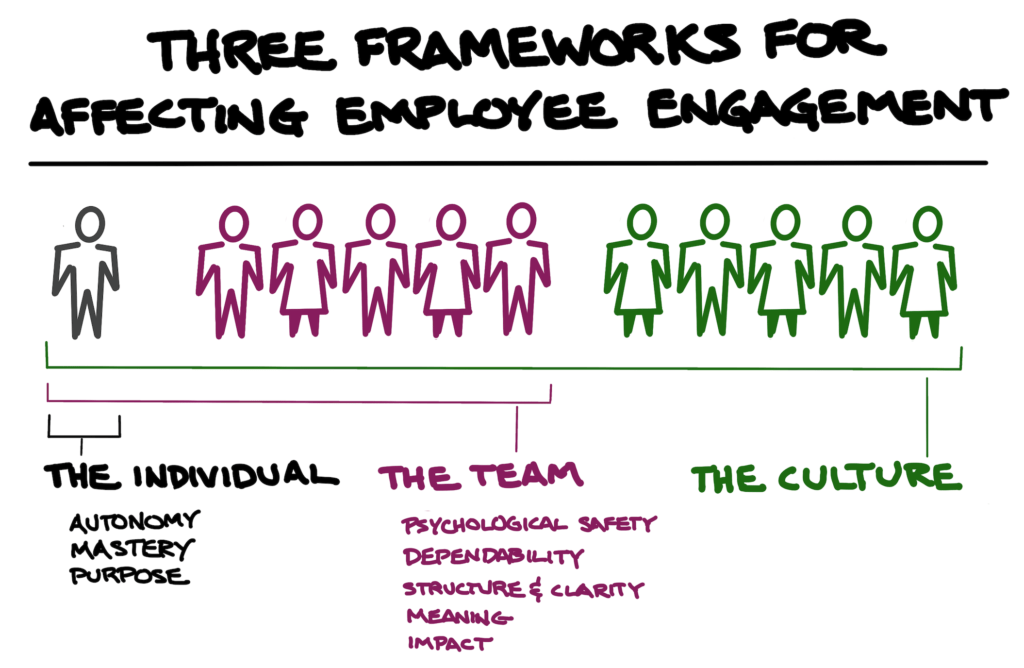
Figure 3: The 5 factors that contribute to high performing teams are added here. Interestingly, some overlap can be seen. A sense of purpose affects individual motivation, while two closely related factors, Meaning, and Impact, contribute to outstanding team performance.
The key to creating team performance is to give employees a sense of Psychological safety, Dependable team members, Structure and Clarity, and a sense of both Meaning and Impact.
The third framework: Improving employee engagement by understanding Organizational Culture
I want to tell you the story of a company with a significant problem in employee retention. In the late 2000s, the company found itself losing 50-70% of employees each year, even though by almost every measure the company was a nice place to work. They treated employees well and provided all kinds of perks, such as free food while at work, transportation, and social activities.
To fix the employee retention problem, the company increased incentives—by boosting salaries and adding perks. But increasing these incentives didn’t make employees stick around any longer. So the company engaged three researchers to run an experiment.
The company took 700 new hires and divided them into three groups. One was the usual control group; they received the standard new employee training. The second group received standard new employee training plus an additional hour that focused on the company’s identity. This included topics such as the company’s successes, the chance to meet a high-performing employee, and answering questions about the new employees’ first impressions of the company. At the end of the hour, they received a fleece sweatshirt embroidered with the company’s name.
The third group also received the standard training, plus an additional hour that was focused on the employee, not on the company. Employees in this group were asked questions like: “What is unique about you that leads to your happiest times and best performance at work?” In another exercise, they were asked to imagine that they were lost at sea and to consider what special skills they might bring to the situation. At the end of the hour, they received a fleece sweatshirt embroidered with their name alongside the company name.
After 7 months, which group do you think had the greatest retention? More importantly, what was the magnitude of the differences between the three groups?
To be transparent, this company did not provide services in the life sciences; it was a call center in India named WIPRO. As you might imagine, retention rates for call centers are pretty poor; in fact, the 50-70% loss rate WIPRO was experiencing was on par for the call-center industry.
The experimenters who ran the study thought the magnitude of any differences between the three arms of the experiment would be small. After all, the additional training only lasted an hour, and the differences between the two types of additional training administered during the experiment were small. And the results were measured after half a year, long after the training itself had probably faded in the participants’ memories.
The experimenter’s expectations were low, but they were confounded. Trainees from the third group were 250 percent more likely than those from the second group and 157 percent more likely than those from the control group to still be employed after 7 months.
For more on the WIPRO experiment, see D. Cable, F. Gino, and B. Stats, “Breaking Them In or Revealing Their Best? Reframing Socialization Around Newcomer Self-Expression.” Administrative Science Quarterly 58 (2013), 1-36. This story was brought to my attention by a book called The Culture Code, The secrets of highly successful groups, by Daniel Coyle.
Coyle identifies three key messages that can create highly successful cultures:
- You are safe (this addresses belonging, connection and identity)
- We share risk (this addresses vulnerability, trust, and cooperation)
- This is our purpose (this is brought to life by sharing common goals, values, and stories)
Safety, Shared Risk, and Purpose. These are the elements that contribute to a highly effective corporate culture.
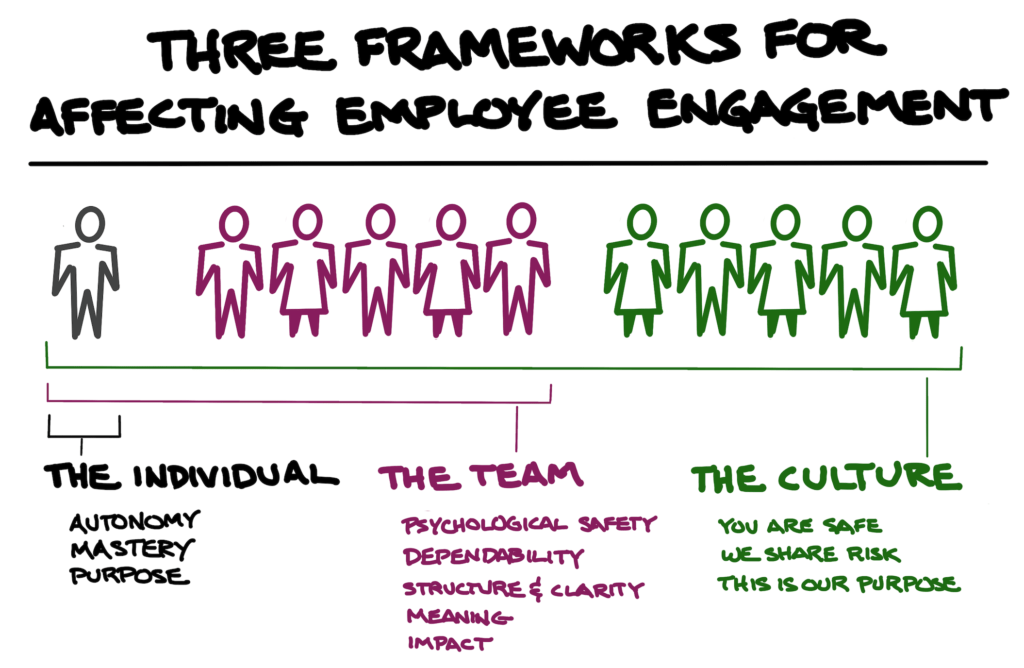
Figure 4: The 3 factors that contribute to a highly effective culture are shown here. You can see that the overlap between the three frameworks is now quite significant. Here are two examples: First, a sense of Purpose affects individual motivation as well as corporate culture, while two closely related factors—Meaning and Impact—contribute to outstanding team performance. Second, a feeling of Safety contributes to high performing teams as well as effective culture.
Summary
Research has revealed the three approaches we can take to maximize employee engagement: maximize Individual Motivation, improve Team Performance and optimize Organizational Culture.
Ignore any one of these at your peril. I ask you to reflect: how deliberately does your organization address any of these? If you’re like most professionals, the answer is “Not much.”
But there is hope.
There is a tool that lets you harness these three frameworks to increase employee alignment and engagement.
Here at Forma, we’ve shown that there are powerful tools that enable management to affect employee engagement: Archetypes. If you’ve been reading these whitepapers, you know that archetypes are patterns we carry in our heads. Archetypes are simple but incredibly effective; for our specific purposes here, they can be a powerful lever enabling you to control the factors making up the three frameworks I’ve just outlined.
How do Archetypes do this? Are there ways that we can deliberately tune an archetype to maximize its ability to affect individual motivation, team performance, and organizational culture? Those are the topics I’ll cover in my next whitepaper.
The Marketing of Science is published by Forma Life Science Marketing approximately ten times per year. To subscribe to this free publication, email us at info@formalifesciencemarketing.com.
David Chapin is author of the book “The Marketing of Science: Making the Complex Compelling,” available now from Rockbench Press and on Amazon. He was named Best Consultant in the inaugural 2013 BDO Triangle Life Science Awards. David serves on the board of NCBio.
David has a Bachelor’s degree in Physics from Swarthmore College and a Master’s degree in Design from NC State University. He is the named inventor on more than forty patents in the US and abroad. His work has been recognized by AIGA, and featured in publications such as the Harvard Business Review, ID magazine, Print magazine, Design News magazine and Medical Marketing and Media. David has authored articles published by Life Science Leader, Impact, and PharmaExec magazines and MedAd News. He has taught at the Kenan-Flagler Business School at UNC-Chapel Hill and at the College of Design at NC State University. He has lectured and presented to numerous groups about various topics in marketing.
Forma Life Science Marketing is a leading marketing firm for life science, companies. Forma works with life science organizations to increase marketing effectiveness and drive revenue, differentiate organizations, focus their messages and align their employee teams. Forma distills and communicates complex messages into compelling communications; we make the complex compelling.
© 2024 Forma Life Science Marketing, Inc. All rights reserved. No part of this document may be reproduced or transmitted without obtaining written permission from Forma Life Science Marketing.
